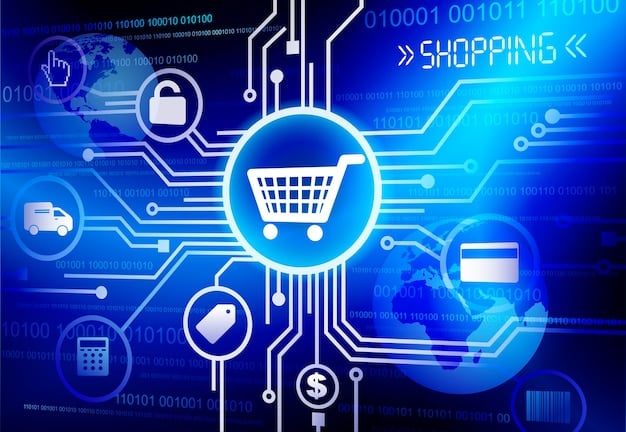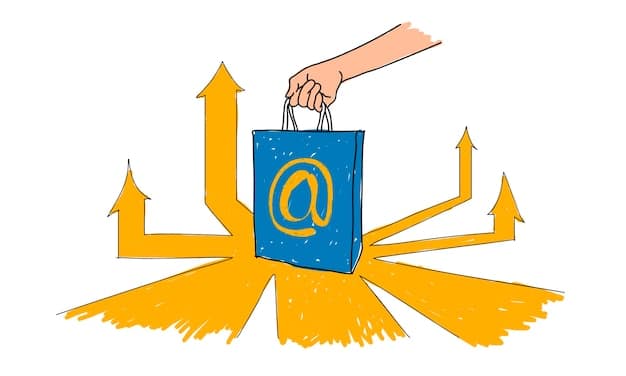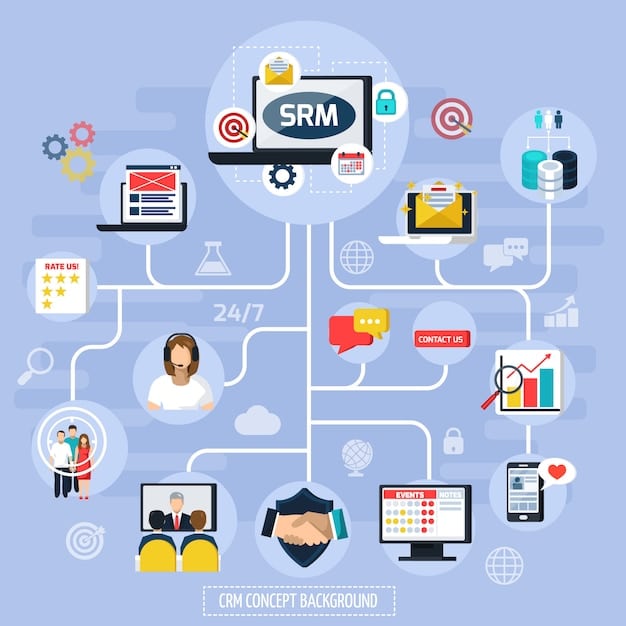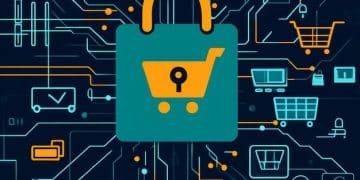Maximize ROI: E-commerce Email Marketing Automation in the US

E-commerce email marketing automation in the US is a powerful strategy to boost return on investment by leveraging data-driven insights to personalize customer journeys, optimize engagement, and drive conversions through targeted, timely communication.
In the competitive US e-commerce landscape, businesses constantly seek strategies to optimize their marketing spend and significantly enhance profitability. Navigating this dynamic environment effectively requires more than just good products; it demands intelligent, data-driven outreach. This is where Maximize Your ROI: A Data-Driven Guide to E-commerce Email Marketing Automation in the US becomes not just a guide, but an essential playbook for sustainable growth, offering a path to deeper customer connections and unparalleled return on investment.
The Strategic Imperative of E-commerce Email Marketing Automation
The digital storefronts of today’s American businesses are bustling, but success isn’t merely about attracting traffic. It’s about converting visitors into loyal customers and maximizing the value of every interaction. In this hyper-connected era, email remains an unconquered king of communication, delivering a reported ROI of up to $42 for every $1 spent. For e-commerce businesses operating within the US, harnessing this power through automation is no longer an option but a strategic imperative. It’s about moving beyond generic blasts to highly personalized, timely, and relevant messaging that resonates directly with the individual consumer.
Automated email sequences allow businesses to engage customers at critical touchpoints throughout their buying journey, from initial interest to post-purchase support. This proactive approach ensures that no opportunity for interaction or conversion is missed, creating seamless experiences that build trust and drive repeat business. The sheer volume of data generated by modern e-commerce—from browsing behavior to purchase history—provides a fertile ground for sophisticated automation strategies, allowing marketers to segment audiences with precision and tailor content dynamically. Without automation, managing such a personalized approach manually would be an insurmountable task for even the largest marketing teams.
Understanding the Core Mechanics
At its heart, email marketing automation involves setting up predefined email workflows that are triggered by specific customer actions or predetermined schedules. These workflows are designed to nurture leads, recover abandoned carts, welcome new subscribers, celebrate milestones, and much more. The beauty of automation lies in its ability to operate around the clock, delivering consistent messaging at scale without continuous manual intervention.
- Trigger-Based Emails: Sent automatically in response to a customer action (e.g., signing up, making a purchase, abandoning a cart).
- Scheduled Campaigns: Timed emails for promotions, newsletters, or seasonal updates, often leveraging segmentation for relevance.
- Personalization at Scale: Dynamic content insertion allows emails to feature a customer’s name, past purchases, or recommended products.
The ultimate goal is to foster a one-on-one relationship with each customer, making them feel valued and understood. This level of personalization, powered by data and automation, is what transforms transactional interactions into lasting customer loyalty, essential for sustainable ROI in the competitive US e-commerce market.
Furthermore, the strategic implementation of email marketing automation extends beyond simple communication. It encompasses the continuous analysis of campaign performance, allowing for ongoing optimization. By tracking open rates, click-through rates, conversion rates, and overall revenue generated, businesses can refine their automation strategies, test different approaches, and ultimately enhance their ROI. This data-driven feedback loop is what differentiates successful automation from mere automated sending, ensuring campaigns remain effective and relevant in an evolving market.
Leveraging Data for Hyper-Personalized Campaigns
In the digital marketing realm, data is the new currency. For e-commerce email marketing automation, leveraging data means transforming raw information into actionable insights that fuel hyper-personalized campaigns. This isn’t just about addressing a customer by their first name; it’s about understanding their unique preferences, behaviors, and buying patterns to deliver content that feels tailor-made. Within the US market, consumers are increasingly demanding personalized experiences, and brands that fail to deliver risk being overlooked.
The journey to hyper-personalization begins with robust data collection and segmentation. E-commerce platforms, CRM systems, and email service providers (ESPs) collect a treasure trove of information, from demographic details to purchase history, browsing activity, and engagement metrics. By effectively segmenting this data, businesses can create highly targeted audience groups, each receiving emails designed to resonate with their specific wants and needs. This granular approach ensures messages are not only received but also acted upon, significantly boosting engagement and conversion rates.
Advanced Segmentation Strategies
Moving beyond basic demographics, advanced segmentation delves into behavioral and psychographic data. This includes understanding the customer’s stage in the buying cycle, their level of brand loyalty, and their preferred product categories. Implementing these segments allows for the creation of highly relevant email sequences.
- Purchase History: Segmenting based on past purchases allows for targeted cross-sell and up-sell opportunities, as well as replenishment reminders.
- Browsing Behavior: Customers who viewed specific products or categories but didn’t purchase can receive follow-up emails with related items or special offers.
- Engagement Level: Segmenting by open rates and click-through rates helps identify highly engaged customers for exclusive content, and less engaged customers for re-engagement campaigns.
The integration of AI and machine learning tools is further accelerating this personalization trend. These technologies can analyze vast datasets to predict future customer behavior, recommend products with unprecedented accuracy, and even optimize email send times for individual users. For US e-commerce brands, this means the ability to deliver truly predictive and proactive marketing messages, often before the customer even realizes they need something.
Ultimately, hyper-personalization powered by data is about building stronger customer relationships. When customers feel understood and valued, they are more likely to engage with a brand, make repeat purchases, and become brand advocates. This deep customer loyalty is a cornerstone of maximizing ROI in e-commerce, creating a sustainable competitive advantage in a crowded marketplace.
Key Automated Email Flows for E-commerce Success
While the potential for email automation is vast, certain key flows consistently deliver high ROI for e-commerce businesses in the US. These flows are designed to address specific customer behaviors and stages of the buying journey, ensuring timely and relevant communication that nurtures leads and drives conversions. Mastering these sequences is fundamental to a thriving automated email strategy.
Each of these automated flows serves a distinct purpose, yet all are united by the common goal of enhancing the customer experience and increasing revenue. They demonstrate the power of proactive engagement, turning potential missed opportunities into successful customer interactions. The effectiveness of these flows lies in their ability to deliver the right message at the right time, minimizing effort for the marketing team while maximizing impact on the customer.

Essential Automated Sequences
Building out these sequences requires careful planning, compelling copy, and robust integration with your e-commerce platform and ESP. Testing and optimization are crucial for refining each flow to achieve peak performance.
- Welcome Series: An essential first step for new subscribers, this sequence introduces your brand, highlights key products, and builds initial rapport. It’s a prime opportunity to set expectations and encourage a first purchase.
- Abandoned Cart Recovery: One of the most effective automation flows, it reminds customers about items left in their cart, often with an incentive, and dramatically increases conversion rates for otherwise lost sales.
- Post-Purchase Follow-Up: This flow enhances customer satisfaction and loyalty by confirming orders, providing shipping updates, offering product care tips, and suggesting complementary products.
- Win-Back Campaigns: Targeted at inactive customers, these emails aim to re-engage them with special offers, new product highlights, or personalized recommendations to bring them back to your store.
Beyond these foundational flows, consider implementing anniversary emails offering special discounts, birthday greetings, or personalized product recommendations based on a detailed analysis of past purchases and browsing behavior. Each automated touchpoint reinforces your brand’s commitment to customer satisfaction and fosters a sense of personal connection.
Moreover, integrating these email flows into a broader customer journey strategy ensures a cohesive brand experience. Mapping out the entire customer lifecycle—from awareness to advocacy—allows businesses to identify every touchpoint where an automated email can add value. This holistic view helps to create a comprehensive and effective email marketing ecosystem that continuously works to boost ROI.
Measuring and Optimizing ROI in Email Automation
Implementing email marketing automation is only half the battle; the other half is rigorously measuring its impact and continuously optimizing for better return on investment. For US e-commerce businesses, understanding which campaigns are driving revenue and which need adjustment is paramount to sustainable growth. A data-driven approach to measurement ensures that resources are allocated efficiently and strategies are refined based on tangible results.
Tracking key performance indicators (KPIs) goes beyond simple open rates. While engagement metrics are important, the true measure of success lies in conversion rates, average order value (AOV), customer lifetime value (CLTV), and ultimately, the direct revenue generated by automation. Establishing clear benchmarks and regularly analyzing these metrics allows marketers to identify strengths and weaknesses within their automated flows, paving the way for informed optimization. This continuous feedback loop is what transforms email automation from a static tool into a dynamic growth engine.
Key Metrics for ROI Assessment
A comprehensive ROI assessment requires looking at a variety of metrics, both individually and in aggregate, to form a complete picture of campaign performance. Focusing solely on vanity metrics can lead to misguided strategies and suboptimal results.
- Conversion Rate: The percentage of email recipients who complete a desired action, such as making a purchase. This is a direct indicator of campaign effectiveness.
- Revenue/Email: The total revenue generated by an email campaign divided by the number of emails sent. This gives a clear monetary value to each email.
- Customer Lifetime Value (CLTV): Automated emails, particularly post-purchase and loyalty campaigns, can significantly influence CLTV by fostering repeat purchases and customer retention.
- Unsubscribe Rate: While a certain rate is normal, a high unsubscribe rate can indicate that emails are irrelevant, too frequent, or poorly targeted, signaling a need for content or segmentation adjustments.
Furthermore, A/B testing is an indispensable tool for optimization. By testing different subject lines, call-to-actions, email content, send times, and even segmentations, businesses can systematically discover what resonates best with their audience. This iterative process of testing, analyzing, and refining ensures that email automation campaigns are always evolving to meet customer expectations and market demands.
The ability to attribute sales directly to specific automated emails provides invaluable insights into which parts of the customer journey are most effectively driven by automation. Modern attribution models and analytics platforms allow for this detailed tracking, enabling businesses to quantify the precise ROI of their email marketing efforts. This detailed understanding supports strategic decision-making and justifies continued investment in sophisticated automation tools.
Tools and Technologies for US E-commerce Automation
The landscape of e-commerce email marketing automation tools is vast and ever-evolving, offering a plethora of options for businesses in the US. Selecting the right platform is critical, as it forms the backbone of your entire automation strategy. The ideal tool should not only facilitate seamless email delivery but also offer robust segmentation capabilities, advanced analytics, and easy integration with your existing e-commerce ecosystem.
Platform choice often depends on the scale of operations, budget constraints, and specific features required. From all-in-one marketing suites to specialized email service providers (ESPs), each tool brings its own strengths to the table. For a US-based e-commerce business, key considerations include compliance with local data privacy regulations, ease of integration with popular e-commerce platforms like Shopify or WooCommerce, and the ability to scale as the business grows.
Top Automation Platforms
Investing in the right technology can significantly streamline your marketing efforts and enhance the effectiveness of your automated campaigns. These platforms provide the necessary infrastructure to execute complex strategies with relative ease.
- Klaviyo: Highly popular in e-commerce, known for its deep integration with e-commerce platforms, advanced segmentation, and robust automation flows.
- Mailchimp: A versatile option, offering user-friendly interfaces, a wide range of templates, and sufficient automation features for small to medium-sized businesses.
- ActiveCampaign: Offers powerful marketing automation, CRM, and sales automation capabilities, allowing for highly complex and personalized customer journeys.
Beyond the core ESP, consider tools for A/B testing, dynamic content generation, and advanced analytics. Some platforms offer these functionalities natively, while others require third-party integrations. The goal is to create a tech stack that works cohesively, providing a comprehensive view of customer interactions and campaign performance.

A crucial aspect of choosing an automation tool is its ability to integrate with your current e-commerce platform. Seamless data flow between your store and your email marketing system is essential for accurate segmentation, trigger-based emails, and personalized content. This integration ensures that customer actions on your website immediately inform your email automation workflows, creating a truly responsive marketing engine.
Ultimately, the best tools are those that empower your marketing team to execute data-driven strategies efficiently, provide clear insights into performance, and offer the flexibility to adapt to changing market conditions. Regular evaluation of your tech stack is advisable to ensure it continues to meet the evolving needs of your e-commerce business.
Compliance and Ethical Considerations in US Email Marketing
Navigating the legal and ethical landscape of email marketing in the US is as crucial as crafting compelling campaigns. Non-compliance can lead to severe penalties, damage brand reputation, and erode customer trust. For e-commerce businesses, adhering to regulations like the CAN-SPAM Act is not merely a formality but a fundamental aspect of building a sustainable and ethical marketing practice.
Beyond legal requirements, ethical considerations play a significant role in fostering long-term customer relationships. Respecting customer privacy, providing transparent communication, and offering easy opt-out options contribute to a positive brand image and cultivate trust. In an era where data privacy concerns are paramount, a proactive approach to ethical marketing strengthens consumer confidence and loyalty.
Key Compliance Directives
The CAN-SPAM Act sets the rules for commercial email in the US, outlining requirements for senders and giving recipients the right to have emails stopped. Understanding and implementing these directives is non-negotiable for any e-commerce business.
- Truthful Header Information: Your “From,” “To,” and routing information—including the originating domain name and email address—must be accurate and identify the person or business who initiated the message.
- Identification as an Advertisement: Emails containing commercial content must clearly and conspicuously disclose that the message is an advertisement.
- Valid Physical Postal Address: All commercial emails must include the sender’s valid physical postal address.
- Clear Opt-Out Mechanism: You must provide a clear and conspicuous way for recipients to opt out of receiving future emails, and process opt-out requests promptly.
Furthermore, businesses should be aware of state-specific regulations that may complement federal laws. For instance, California’s CCPA (California Consumer Privacy Act) introduces additional obligations regarding consumer data, impacting how e-commerce businesses collect, use, and share customer information, including for email marketing purposes. Staying informed about these evolving regulations is vital.
Ethical considerations extend to the frequency and relevance of emails. Bombarding customers with excessive or irrelevant messages can quickly lead to unsubscribes and negative perceptions. Curating content that provides value and aligns with customer preferences demonstrates respect for their inbox and reinforces positive brand associations. Ultimately, a balanced approach—one that is both compliant and ethical—is the cornerstone of effective and responsible email marketing automation in the US.
Future Trends in E-commerce Email Automation for US Markets
The future of e-commerce email marketing automation in the US is poised for significant innovation, driven by advancements in artificial intelligence, real-time data processing, and an increasing demand for hyper-personalized experiences. Staying ahead of these trends will be crucial for businesses looking to maintain a competitive edge and continuously maximize their ROI.
We are moving beyond simple trigger-based emails towards a more predictive and adaptive approach. AI and machine learning will enable email systems to anticipate customer needs, personalize content at an unprecedented level, and optimize send times not just by segment, but at an individual level. This shift towards intelligent orchestration promises to make email communication even more seamless and effective, further blurring the lines between marketing and personalized customer service.
Emerging Technologies and Methodologies
The next wave of innovation will see email automation becoming even more integrated into the broader customer experience, acting as a central nervous system for personalized engagement across multiple channels.
- Predictive Analytics: AI-driven engines will analyze vast customer data to predict purchasing patterns, ideal product recommendations, and potential churn risks, triggering highly targeted proactive emails.
- Dynamic Content at Scale: Emails will feature increasingly dynamic content, adapting in real time based on recipient behavior, weather, location, and even stock availability.
- Omnichannel Integration: Email automation will become more deeply intertwined with other marketing channels (SMS, social media, push notifications) to create cohesive and personalized customer journeys across all touchpoints.
- Enhanced Interactivity: Expect to see more interactive elements within emails, such as quizzes, polls, forms, and even mini-games, aiming to increase engagement directly within the inbox.
Voice search and conversational AI are also likely to influence how e-commerce email automation evolves. As more consumers interact with brands through voice assistants, email content may need to be optimized for audio consumption or trigger voice-enabled responses. This represents a new frontier for delivering engaging and accessible marketing messages.
Ultimately, the successful e-commerce businesses in the US will be those that embrace these emerging technologies, not as replacements for human creativity, but as powerful enhancements. The trend is towards increasingly sophisticated, data-driven, and ethical automation that respects customer privacy while delivering unparalleled value, ensuring email remains a powerhouse for ROI in the years to come.
| Key Aspect | Brief Description |
|---|---|
| 📈 Data-Driven Personalization | Utilizes customer data to craft highly relevant and targeted email content, boosting engagement. |
| 🛒 Automated Workflows | Sets up triggered email sequences for welcome, abandoned cart, and post-purchase to nurture leads. |
| 📊 ROI Measurement & Optimization | Crucial for tracking KPIs like conversions and revenue to continuously refine strategies. |
| 🔒 Compliance & Ethics | Adherence to regulations like CAN-SPAM and ethical practices builds trust and avoids penalties. |
Frequently Asked Questions About E-commerce Email Automation
E-commerce email marketing automation refers to the process of sending automated, targeted emails to customers and prospects based on their behavior, preferences, and journey through your online store. This includes welcome series, abandoned cart reminders, and post-purchase follow-ups without manual intervention.
It boosts ROI by delivering personalized and timely messages that increase engagement, drive conversions, and foster customer loyalty. By re-engaging abandoned carts and offering relevant product recommendations, automation directly translates into higher sales and a greater return on marketing investment.
Crucial data includes customer demographics, purchase history, browsing behavior (pages viewed, products added to cart), engagement with previous emails, and stated preferences. This information enables segmentation and dynamic content creation, leading to genuinely relevant communications.
New e-commerce ventures should prioritize welcome series for new subscribers, abandoned cart recovery emails, and basic post-purchase follow-ups. These flows address critical touchpoints in the customer journey and offer the most immediate impact on conversions and customer experience.
In the US, the primary compliance aspect is the CAN-SPAM Act. Key requirements include accurate sender information, clear identification of commercial messages, a valid physical address, and a conspicuous, functional opt-out mechanism for recipients. State laws like CCPA may also apply.
Conclusion
In the vast and ever-evolving landscape of American e-commerce, mastering email marketing automation is no longer a luxury but a fundamental pillar for maximizing ROI. By leveraging data to craft hyper-personalized campaigns, implementing strategic automated flows, and rigorously measuring performance, businesses can transform fleeting interactions into lasting customer relationships. Adhering to compliance standards and embracing emerging technologies further solidifies this strategy, ensuring that every email sent contributes meaningfully to growth and profitability. The journey towards optimized e-commerce ROI is continuous, driven by intelligent automation and a profound understanding of the customer at every step.





